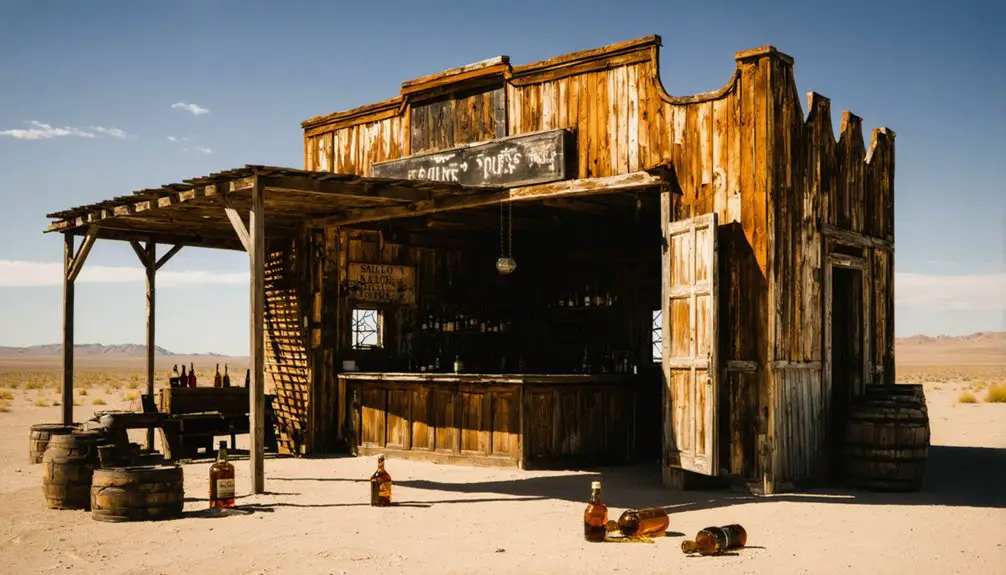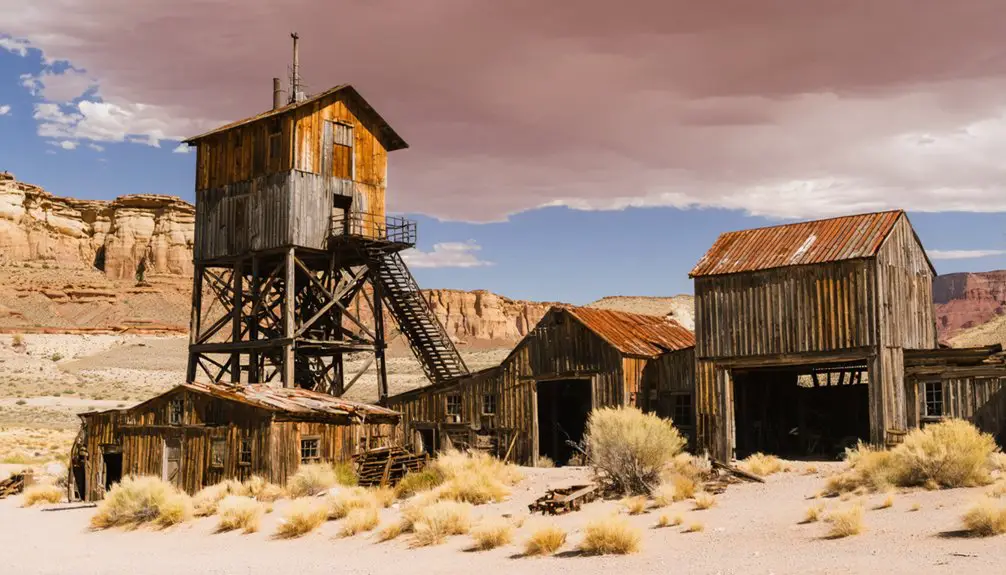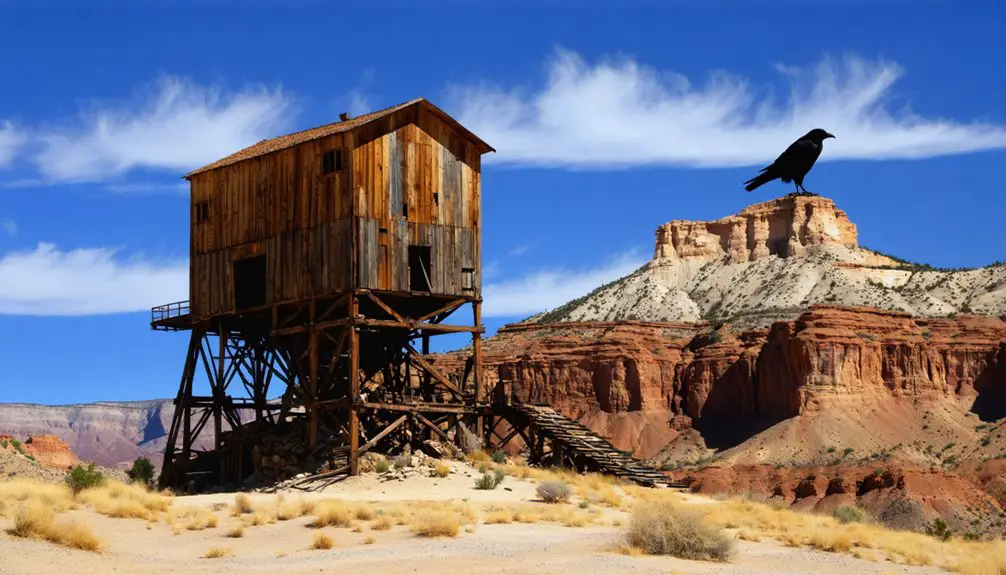You’ll find Frisco’s haunting remains in Utah’s San Francisco Mountains, where this former silver boomtown peaked at 6,000 residents in 1885. The Horn Silver Mine, once the world’s richest silver producer, anchored a bustling community with 23 saloons until its catastrophic collapse in February 1885. Today, five towering beehive kilns stand as silent sentinels on the National Register of Historic Places, marking an era when lawmen and outlaws shaped this Wild West settlement’s dramatic story.
Key Takeaways
- Frisco was a booming Utah mining town that peaked at 6,000 residents in 1885 before becoming a ghost town by 1920.
- The town’s decline began with the catastrophic collapse of the Horn Silver Mine in 1885, which was once the world’s richest silver mine.
- Five historic beehive charcoal kilns, now on the National Register of Historic Places, remain as the main visible remnants of Frisco.
- During its heyday, Frisco featured 23 saloons and required strict law enforcement, including a sheriff with a shoot-to-kill policy.
- The site contains ruins, a cemetery, and remnants of mining operations that produced $60 million in metal by 1885.
The Rise of a Mining Empire
When prospectors James Ryan and Samuel Hawks discovered a massive ore body in September 1875, they unknowingly sparked the birth of one of Utah’s most significant mining empires.
Although they sold their claim due to uncertainty, the Horn Silver Mine would go on to produce ore worth $20 million by 1910.
You’ll find that mining techniques evolved rapidly as the San Francisco Mining District expanded.
The construction of five beehive-shaped charcoal kilns and a smelter in 1877 revolutionized local ore processing.
But it was the railroad expansion in 1880 that truly transformed Frisco’s potential, enabling the transport of 150 tons of ore daily to Salt Lake Valley.
The district’s success attracted thousands, with complementary mines like the Blackbird, Cactus, and Imperial contributing to a staggering $60 million in metal production by 1885.
The Horn Silver Mining Company was officially incorporated in February 1879, marking a new era of organized mining operations.
The town’s population swelled to nearly 6,000 residents by 1880 as miners and their families flocked to the booming settlement.
Life in the Wild West Boomtown
As Frisco blossomed into one of Utah’s most notorious boomtowns, its population swelled to 6,000 residents by 1885, transforming the once-quiet desert into a bustling hub of miners, merchants, and fortune-seekers.
You’d have found yourself immersed in a wild mining culture where 23 saloons, gambling halls, and brothels dominated the nightlife. The transient lifestyle attracted a diverse mix of characters, from hardworking miners to dangerous outlaws. To help visitors and residents navigate the various establishments, the town maintained disambiguation signage throughout its streets.
With no jail in sight, Sheriff William Pearson maintained order through lethal force, reportedly killing six outlaws on his first night alone.
Daily life wasn’t easy – you’d have to rely on imported drinking water while maneuvering through hastily built wooden structures. The devastating Horn Silver Mine collapse in 1885 marked the beginning of the town’s steady decline.
Yet the town’s spirit thrived, fueled by the promise of silver, lead, and gold in the nearby mines, despite the constant threat of violence in this untamed frontier.
The Horn Silver Mine’s Fatal Collapse
On the morning of February 12, 1885, you’d have witnessed the catastrophic collapse of the Horn Silver Mine, where poor engineering and heavy winter precipitation created the perfect storm for disaster.
You’ll find that inadequate tunnel timbering, combined with water-soaked volcanic rocks in the hanging wall, triggered a cave-in so powerful it shattered windows in Milford, over ten miles away.
The collapse sealed off access to the mine’s richest veins and launched Frisco’s transformation from a 6,000-person boomtown into a ghost town, as the once-productive mine never fully recovered despite operating sporadically for several more decades. Remarkably, due to the timing of the incident during the post-midnight hours, no miners lost their lives in the devastating collapse. Prior to the disaster, the Horn Silver Mine had earned its reputation as the richest silver mine in the world by 1879.
The Fatal February Disaster
Just after midnight on February 12, 1885, the Horn Silver Mine experienced a catastrophic collapse that would forever alter Frisco’s destiny.
Earlier mining safety warnings had gone unheeded as tremors shook the ground, forcing the day shift to stay above ground. The geological instability culminated in a collapse so powerful it shattered windows in Milford, over 10 miles away.
You’ll find it remarkable that despite the mine’s main shaft and tunnels caving in down to the seventh level, no casualties occurred since the collapse happened between shifts. The Tintic Lead Company would later acquire the struggling operation in 1928.
The disaster sealed off access to the richest silver ore veins, which had previously yielded over $13 million in production. While attempts to reopen the mine began less than a year later, the Horn Silver would never regain its former glory.
Engineering Flaws and Weather
While the Horn Silver Mine’s collapse seemed sudden, engineering flaws and adverse weather conditions had long set the stage for disaster.
You’ll find that hasty operations led to insufficient timber supports being carelessly installed throughout the mine’s maze-like tunnels. Poor engineering oversight ignored the risks of weak timbering, while recent rain and snow had severely compromised the supports’ load-bearing capacity.
The geological instability of the volcanic rock formations made matters worse. You can trace how heavy precipitation saturated the soil and rock above, adding crushing weight to already strained supports. The mine’s impressive 17 million ounces of silver production likely contributed to the aggressive pace of excavation that weakened structural integrity.
Ground tremors, likely amplified by these wet conditions, served as final warnings before the inevitable. Despite documented cave-ins and clear signs of danger, mine management continued to prioritize rapid extraction over critical safety improvements. The devastating February 12 collapse permanently altered the mine’s productivity and marked the beginning of Frisco’s decline.
Economic Impact and Aftermath
Before the catastrophic mine collapse in 1885, Frisco stood as a thriving boomtown of over 6,000 residents, fueled by the Horn Silver Mine’s remarkable production of $13 million in silver and $4 million in shareholder dividends.
The collapse triggered an immediate economic downturn that transformed Frisco into a ghost town.
You’ll find that the population plummeted to just 500 by 1900 and further decreased to 150 by 1912.
While mining operations resumed within a year, they never reached their former glory.
The mine’s legacy continued for decades, producing 17 million ounces of silver, 25,000 ounces of gold, and massive quantities of copper and lead.
However, quarterly dividends by 1891 averaged only $50,000, a fraction of peak earnings.
The disaster effectively ended Frisco’s reign as Utah’s premier mining hub.
Tales of Lawlessness and Order

As silver wealth poured from the Horn Silver Mine in 1875, Frisco transformed from a barren desert outpost into a notoriously lawless boomtown that rivaled Dodge City and Tombstone in its reputation for violence.
With 21 saloons, gambling halls, and brothels, the town of 6,000 descended into social chaos where murders became so frequent that officials created special body removal services. Today, visitors can explore the abandoned stone kilns that remain as silent sentinels of this turbulent era.
You’d find little law enforcement until Marshal William Pearson arrived from Nevada. He instituted a bold shoot-to-kill policy, gunning down six outlaws on his first night. His ruthless approach proved effective – criminals fled, and order emerged from the mayhem.
But when the mine collapsed in 1885, Frisco’s brief period of stability crumbled. By the 1920s, the town lay abandoned, leaving only ruins and a cemetery as evidence of its violent past.
Legacy in Stone: The Beehive Kilns
You’ll find Frisco’s most enduring symbols in the five surviving beehive kilns, constructed between 1877 and 1880 by the Frisco Mining and Smelting Company.
These remarkable stone and brick structures, which converted wood into charcoal for silver smelting, stand as proof of the area’s industrial prowess, with each kiln measuring between 16 and 32 feet in diameter.
Now preserved on the National Register of Historic Places since 1982, these iconic kilns offer you a rare glimpse into the technological ingenuity that powered Utah’s 19th-century mining boom.
Historic Industrial Marvel
During the late 1870s, the Frisco Mining and Smelting Company constructed a remarkable network of beehive-shaped charcoal kilns that would become enduring symbols of Utah’s industrial heritage.
You’ll find five surviving kilns from the original thirty-six, showcasing exceptional industrial architecture with diameters ranging from 16 to 32 feet. Built primarily of granite, brick, and stone, these structures were expertly designed for peak charcoal production to fuel the region’s silver smelting operations.
These engineering marvels supported the Horn Silver Mine‘s massive output, which yielded over $20 million in ore by 1910.
While the mine’s cave-in of 1885 and the company’s closure in 1884 marked the end of an era, these kilns stand as a testament to American mining ingenuity, now preserved on the National Register of Historic Places.
Preservation Through Time
Standing as silent sentinels to Utah’s industrial past, Frisco’s five surviving beehive kilns showcase remarkable architectural endurance through their brick, stone, and granite construction.
These 26-foot-tall structures have weathered over a century of exposure while maintaining their distinctive beehive shape, earning recognition on the National Register of Historic Places since 1982.
The historical significance of these kilns extends beyond mere preservation:
- They’re among the last remaining structures from Frisco’s 6,000-person boomtown era
- You’ll find original soot deposits that reveal evolving fuel technologies
- Their varying diameters (16-32 feet) demonstrate diverse industrial capabilities
- They represent a $500-$1000 per-kiln investment, showcasing the era’s economic commitment
Despite facing weathering and vandalism challenges, these kilns continue serving as invaluable windows into Utah’s mining heritage.
From Prosperity to Ghost Town

While Frisco initially thrived as a bustling mining town with 6,000 residents and millions in mineral wealth, its prosperity came to an abrupt end following the catastrophic Horn Silver Mine collapse of 1885.
Poor mining techniques and inadequate tunnel supports, combined with harsh weather conditions, led to the devastating cave-in that reached the seventh level of operations. Though no lives were lost, you’d have witnessed the town’s swift decline as mineral production plummeted.
The complex social dynamics that had created a notoriously lawless atmosphere, with 23 saloons and frequent violence, gradually disappeared as residents abandoned the area.
Frequently Asked Questions
Is It Legal to Explore and Collect Artifacts From Frisco Today?
You can’t just grab history like it’s a yard sale! Artifact preservation laws and legal regulations mean you’re only allowed to explore designated areas and must leave all items exactly where they are.
What Wildlife and Natural Hazards Should Visitors Watch Out For?
Watch for rattlesnakes, scorpions, and wildlife encounters with chipmunks and birds. You’ll need to navigate hazardous mine shafts, unstable ground, and extreme desert conditions including intense heat and sudden storms.
How Far Is Frisco From the Nearest Modern Town or Emergency Services?
You’ll feel a million miles from civilization, but Milford’s emergency services are 15 miles west via paved UT-21. For travel safety, remember Beaver’s fuller services require 45-mile road access northeast.
Are There Any Documented Paranormal Activities or Ghost Sightings in Frisco?
You’ll discover numerous documented ghost encounters, from shadowy figures to spectral horseback riders. Visitors report Old West apparitions in abandoned buildings, with the cemetery’s haunted history drawing paranormal investigators.
What Months Offer the Best Weather Conditions for Visiting Frisco?
With highs reaching 95°F in July, you’ll find the best visiting months are May through September. You’ll enjoy warm days perfect for exploring, while avoiding winter’s harsh conditions and limited daylight.
References
- https://www.islands.com/1830959/utah-once-booming-mining-town-frisco-famous-abandoned-desert-wonder-near-zion-national-park/
- https://historytogo.utah.gov/horn-silver-mine/
- https://www.legendsofamerica.com/ut-frisco/
- https://www.frrandp.com/2021/03/frisco-ut.html
- https://en.wikipedia.org/wiki/Frisco
- https://www.uen.org/utah_history_encyclopedia/f/FRISCO_MINING_CAMP.shtml
- https://onlineutah.us/frisco_history.shtml
- https://utahrails.net/mining/frisco-mine.php
- https://www.atlasobscura.com/places/frisco-ghost-town
- https://www.youtube.com/watch?v=enta4tlFHcU



